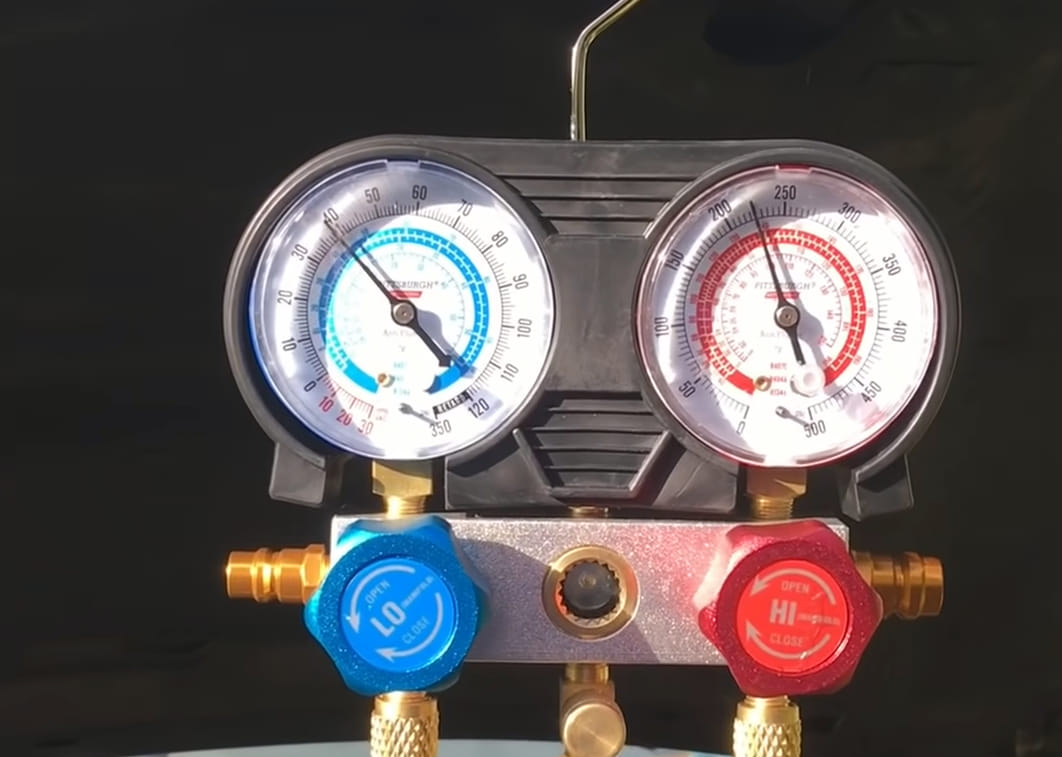We have heard many people ask us about how much vacuum to pull on auto AC system.
Your car’s refrigeration system operates effectively only with the oil and refrigerant circulating inside it. When the AC system is serviced or assembled, there is air that gets into the system.
There is nitrogen, oxygen, as well as water vapor in the air, and these are not ideal to your AC system. This is why you need to remove these by using a vacuum pump, which is also called “degassing the system.”
When you remove water vapor and air out of the AC system, it is called evacuation, and this is important in ensuring the performance of your unit.
Find out how much vacuum you need to pull on your auto AC system, why it needs to be done, and how you can do it.

Contents
How Much Vacuum To Pull On Auto AC System
Once you have gotten your AC system opened for installation, repair, or any service – even if it is only for a short period of time – you need to make sure to have it evacuated. You can do this best by pulling a deep vacuum in your AC system. This is to remove any non-condensable gas that wreaks havoc to this component.
When you have the vacuum pump hooked up to the high and low air conditioning system sides, be sure to pull a vacuum for about 5 minutes up to 45 minutes. You need to use a vacuum with 29.92 hg gauge pressure or around 500 microns, as this removes moisture and non-condensable gas that have entered the AC system while remaining open.
In addition to pulling a deep vacuum, you should also replace the AC/ receiver and drier that helps to regulate the moisture in the system.
If you fail to vacuum your AC system, this will cause non-condensable gasses to remain in the unit. Then, they will not be capable of condensing in the AC condenser, not like what the R-1234yf or R-134a can do.
Over time, these gasses can have a negative impact on your AC system’s performance, lifespan, and operating conditions.
Your vehicle’s AC system has two sides – the high pressure with high temperature and the low pressure with low temperature. When the non-condensable gas remains, this is not able to flow to your condenser outlet, making it trapped in your condenser tubing.
As a result, there will be a displacement of the space occupied by the refrigerant for the purpose of condensation and heat transfer. Hence, air will minimize the vapor’s heat transfer coefficient in the tube. With the condenser’s reduced heat transfer ability and the refrigerant’s poor cooling down performance, this leads to a spike to the refrigerant’s temperature in comparison to the air temperature. Thus, there will be a high discharge pressure.
Moreover, the compressor receives an extra load as the system continues to work at a high pressure. The system’s overall energy efficiency goes down, as well.
The compressor temperature and discharge pressure increases, at the same time, which maximizes the lubricant breakdown and shortens the lifespan of the compressor. Furthermore, the air that holds oxygen establishes poor chemistry in the system. Corrosion occurs from the inside and outside of the aluminum parts of the AC system, including the evaporators.
Importance of Vacuuming The AC System
When you no longer feel a cool breeze coming out of your AC system, it may be time to vacuum it. Since moisture or dust accumulates in the system, this deteriorates its performance and lifespan. Which is why it is very important to keep the system well-maintained to make sure it continues to work efficiently.
Before you start evacuating or vacuuming the AC system, you need to park your vehicle in the garage or any place where there is a flat surface. Then, wear protective glasses and gloves to stay safe while you perform this task.
Identify and prepare all service ports – usually the high service port comes with a larger size than its lower counterpart.
Next, attach the manifold gauge. The set of gauges establish a link between your high/ low pressure ports and the AC system. Make sure the hose of your vacuum pump is connected to the manifold gauge’s low pressure port.
Then, make all the right connections. The valves should also remain closed prior to connecting them to your Ac system.
At this point, you should be ready to start pulling vacuum into your car. The connections should be tight and secure. You may also want to taunt your actual port value to your refrigerant’s lines.
Before you begin, the readings on the gauges should be at zero. Connect the other end of your yellow hose on your gauge and to the vacuum pump. The pump should be switched on, then the pressure needs to be tracked. Overall, it should take about 30 minutes to under an hour for evacuating your auto system. This should be a decent time to make sure dust and moisture are no longer in your AC system.
There are those who leave their vacuum for under 30 minutes while others go over this time. As for a few others, it only takes them up to 10 minutes.
Read More: Will A Bad Fan Clutch Cause Ac Problems? Signs And Effects Of Bad Fan Clutch
Final Thoughts
By understanding how to pull on auto system, as well as how long it takes, you should be well-equipped when it comes to doing this task yourself. Just be sure to follow these instructions before performing this task. By doing so, you can achieve the results you want without breaking the bank of causing complications to the system.
Then, you can keep the AC system of your vehicle well-maintained and performing well, which also prolongs its lifespan and reduces the high risk of a costly repair work any time soon.